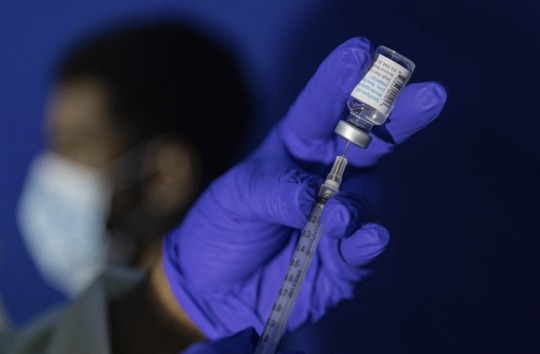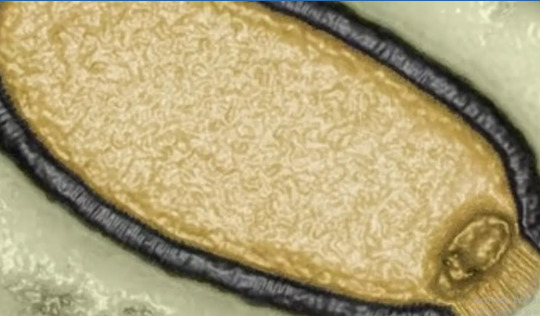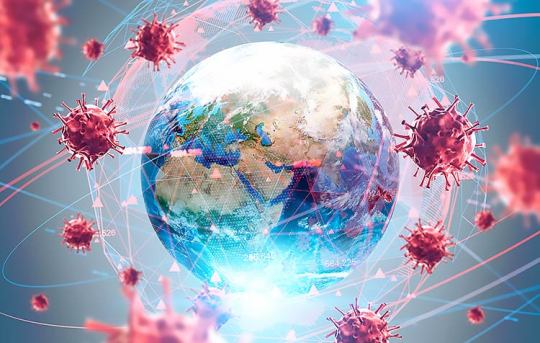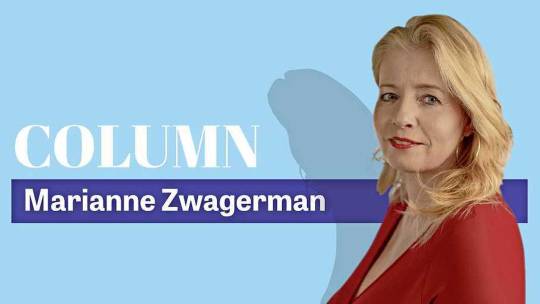#marion koopmans
Explore tagged Tumblr posts
Text
WHO Declares Mpox a Global Health Emergency

In response to the alarming rise in mpox cases in the Democratic Republic of Congo (DRC) and its spread to neighboring countries, the World Health Organization (WHO) has declared a global health emergency. This is the highest alert level under international health regulations.
On Wednesday, WHO Director-General Tedros Adhanom Ghebreyesus announced the decision after a special meeting of experts. “The emergency committee has advised that the current situation constitutes a Public Health Emergency of International Concern (PHEIC), and I have accepted this advice,” Tedros stated at a press conference.
The PHEIC designation is a serious move, signaling the need for a coordinated global response to tackle the outbreak and prevent further loss of life. Tedros expressed concern over the emergence of a new mpox strain in eastern DRC and its detection in neighboring countries like Burundi, Kenya, Rwanda, and Uganda.
The situation is dire. This year alone, over 14,000 cases and 524 deaths have been reported in the DRC, surpassing last year’s totals. The new pox strain, clade 1b, which seems to spread primarily through sexual contact, is particularly troubling.
Dimie Ogoina, who led the emergency committee, described the upsurge as “an extraordinary event,” warning that without stronger surveillance, the full scale of the crisis remains unclear. Maria Van Kerkhove, WHO’s head of emerging diseases, stressed that halting pox transmission is possible with concerted effort but emphasized the need for a better understanding of the disease’s spread.
Mpox, formerly known as monkeypox, was first identified in the DRC in 1970. It is a viral infection that spreads from animals to humans and can also be transmitted between people through close contact. Symptoms include fever, muscle aches, and distinctive skin sores.
This is the second PHEIC declaration for pox, following the global outbreak in 2022 linked to the clade 2b strain, which primarily affected men who have sex with men. That outbreak, which lasted from July 2022 to May 2023, saw nearly 140 deaths from around 90,000 cases. The current clade 1b strain is more severe, with a higher fatality rate.
PHEICs have only been declared a few times since 2009, for issues like H1N1, polio, Ebola, Zika, and COVID-19. Marion Koopmans from Erasmus University highlighted that while a PHEIC raises international alarm, the core needs—improving diagnostic capabilities, public health responses, treatment support, and vaccination—remain the same. The DRC and its neighbors face significant resource challenges in addressing this outbreak.
The International Federation of Red Cross and Red Crescent Societies (IFRC) is ramping up preparedness efforts across Africa, particularly in the hard-hit eastern DRC, to help contain the disease in the most affected areas.
#news#health and wellness#world health organization#breaking news#trending news#pandemic#mpox#outbreak#monkeypox
2 notes
·
View notes
Text
'Zombie' Virus Dormant for 48,500 Years in Arctic Ice Raises Global Health Concerns, Say Scientists
Scientists are sounding the alarm about potential threats posed by ancient viruses lying dormant under Arctic ice caps. The melting Arctic permafrost, driven by rising global temperatures, could release these ‘zombie viruses,’ potentially triggering a catastrophic global health crisis, according to a report in The Guardian. The risks associated with these viruses gained attention when a geneticist successfully revived some of them from samples taken from Siberian permafrost last year, shedding light on the potential dangers they may pose.

Geneticist Jean-Michel Claverie of Aix-Marseille University highlighted the oversight in pandemic threat analyses, noting that the focus has traditionally been on diseases emerging in southern regions and spreading north. However, the threat of an outbreak originating in the far north and traveling south has been relatively neglected. Claverie explained, “There are viruses up there that have the potential to infect humans and start a new disease outbreak.”
Scientists, including Marion Koopmans of the Erasmus Medical Center in Rotterdam, share concerns about the unknown viruses lying dormant in the permafrost. Koopmans emphasized, “We don’t know what viruses are lying out there in the permafrost, but I think there is a real risk that there might be one capable of triggering a disease outbreak — say of an ancient form of polio. We have to assume that something like this could happen.”
Despite being frozen for thousands of years, live viruses recovered from Siberian permafrost have demonstrated the ability to infect single-celled organisms. The researchers, led by Claverie, isolated viruses in 2014 that could infect amoebae, and subsequent investigations identified virus strains capable of infecting cultured cells. One such virus sample dated back an astonishing 48,500 years.
Jean-Michel Claverie stated, “The viruses we isolated were only able to infect amoebae and posed no risk to humans. However, that does not mean that other viruses — currently frozen in the permafrost — might not be able to trigger illnesses in humans. We have identified genomic traces of poxviruses and herpesviruses, which are well-known human pathogens, for example.”
The permafrost, covering a fifth of the Northern Hemisphere, has acted as a time capsule, preserving extinct creatures and ancient viruses. As the Arctic region experiences warming at a rate several times faster than the global average, the disappearance of Arctic sea ice is also contributing to increased shipping, traffic, and industrial development in Siberia. This poses a particular threat as large-scale mining operations are planned, potentially releasing vast amounts of pathogens into the environment.
“The danger comes from another global warming impact: the disappearance of Arctic sea ice. That is allowing increases in shipping, traffic, and industrial development in Siberia. Huge mining operations are being planned, and are going to drive vast holes into the deep permafrost to extract oil and ores. Those operations will release vast amounts of pathogens that still thrive there. Miners will walk in and breathe the viruses. The effects could be calamitous,” warned Claverie.
0 notes
Text
Bulletin Académie Vétérinaire France, BAVF - 2023, tome 176
See on Scoop.it - Insect Archive
Le «Bulletin de l’Académie Vétérinaire de France » publie des articles dans les domaines scientifiques, techniques, juridiques, historiques et éthiques où s'exercent les compétences du vétérinaire, incluant le concept d’unicité de la santé "One health". Il publie également les Actes officiels de l’Académie Vétérinaire de France. Les contributions sont en langue française ou anglaise.
Académie Vétérinaire de France
2023, tome 176
ENGAGEMENT DE L’ACADÉMIE VÉTÉRINAIRE DE FRANCE AU SEIN DE LA FÉDÉRATION EUROPÉENNE DES ACADÉMIES DE MÉDECINE (FEAM). COMPTE RENDU DE LA SÉANCE DU 5 OCTOBRE 2023
Stefan CONSTANTINESCU, Christophe ROUSSELLE, Jean-Jacques SOULA, Anne-Marie VANELLE, André JESTIN
https://doi.org/10.3406/bavf.2023.71062
STOMOXES : NUISANCE, VECTEURS POTENTIELS ET LUTTE INTÉGRÉE
Gérard DUVALLET
https://doi.org/10.3406/bavf.2023.71061
ONE HEALTH (UNE SEULE SANTÉ) : CONCEPT NOUVEAU EN MATURATION OU VIEILLE HISTOIRE ?
Patrick GIRAUDOUX
https://doi.org/10.3406/bavf.2023.71063
PRIX DE THÈSE D’UNIVERSITÉ DE L’AVF 2022 : UNE APPROCHE TRANSLATIONNELLE DE LA RECHERCHE SUR LAPHYSIOPATHOLOGIE DE LA SCHIZOPHRÉNIE ET LES INTERACTIONSGÈNES-ENVIRONNEMENT
Fanny DEMARS, Boris CHAUMETTE, Thérèse JAY, Marco POMPILI, Marie-Odile KREBS
https://doi.org/10.3406/bavf.2023.71057
PRÉVENTION DE LA PROPAGATION DES ZOONOSES : DE « COMPTER SUR LA RÉPONSE » À « RÉDUIRE LE RISQUE A LA SOURCE »
Traduction par Patrick GIRAUDOUX et Serge MORAND de PREVENTION OF ZOONOTIC SPILLOVER: FROM RELYING ON RESPONSE TO REDUCING THE RISK AT SOURCE One Health High-Level Expert Panel (OHHLEP) : Wanda MARKOTTER , Thomas C. METTENLEITER , Wiku B. ADISASMITO , Salama ALMUHAIRI , Casey BARTON BEHRAVESH , Pépé BILIVOGUI , Salome A. BUKACHI , Natalia CASAS , Natalia CEDIEL-BECERRA , Dominique F. CHARRON , Abhishek CHAUDHARY , Janice R. CIACCI ZANELLA , Andrew A. CUNNINGHAM , Osman DAR , Nitish DEBNATH , Baptiste DUNGU , Elmoubasher FARAG , George F. GAO , David T. S. HAYMAN , Margaret KHAITSA , Marion P. G. KOOPMANS , Catherine MACHALABA , John S. MACKENZIE , Serge MORAND , Vyacheslav SMOLENSKIY , Lei ZHOU
https://doi.org/10.3406/bavf.2023.71059
LA POLLINISATION PAR LES ABEILLES CERTES, MAIS N’OUBLIEZ PAS LES AUTRES POLLINISATEURS !
Mohamed GHARBI
https://doi.org/10.3406/bavf.2023.71058
(...)
0 notes
Text
📆 27 Dec 2022 📰 Three years on, the pandemic — and our response — have been jolting. Here’s what even the experts didn’t see coming ✍️ Helen Branswell 🗞 STAT
The biggest surprise, hands down: How the virus has evolved
In the early days of the pandemic, before the new virus had a name, people who had studied coronaviruses offered reassuring predictions about the stability of the virus, which has implications for how often people might be reinfected and how frequently vaccines would need to be updated.
Coronaviruses don’t change very quickly, they aren’t as mutable as, say, influenza viruses, those experts said. In fact, the spike protein on the virus’ exterior, the one that attaches to human cells and triggers infection, cannot change too much without losing its ability to infect, they assured the rest of us.

Many of the people STAT interviewed cited SARS-CoV-2’s evolution as their biggest surprise of the pandemic. “It’s been wild, in my view,” said Marion Koopmans, head of virology at Erasmus Medical Center in Rotterdam, the Netherlands.
Anthony Fauci, retiring head of the National Institute of Allergy and Infectious Diseases, also listed it as his number 1 surprise. “What has surprised me most about Covid is the continual evolution of new variants leading to an unprecedented persistence of the pandemic phase over three years,” he said.
... Most viruses evolve in a stepwise fashion known as “drift,” adding change after change to an existing strain. But some of the Covid variants look more like old versions of the virus were hyper mutated, possibly in a persistently infected person. When those viruses started to spread, they replaced the viruses that had been circulating. The Alpha, Beta, Gamma and Omicron variants of concern are examples of this type of evolution, called saltation, Thomas Peacock and colleagues wrote in a preprint article posted in late November.
0 notes
Text


OMT we hate you BOOOOO
#oenenophetweb runnen werd lastig want sinds deze pandemie werd steeds duidelijker dat de ergste bs van bovenaf komt#oenen op het web#oenenophetweb#omt#marion koopmans#covid-19#'vooral verkoudheid' gore klootzak je weet dondersgoed dat long covid en grote toegenomen kans op ziektes en sterfte er ook bij hoort
8 notes
·
View notes
Text
Hate to always harp on it but like 👀 a feud with Kross that ends in a crazy insane and violent match wherein Finn loses the NXT title to Kross and Scarlett and their magical darkness could...yah know...bring back The Boy
#finn balor#marion koopmans#wwe#nxt#Scarlett bordeaux#LOOK OKAY LISTEN HEAR ME OUT ALRIGHT#dark magical weirdness and devastation.....could be what causes the BEAST TO AWAKEN#I miss the paint y’all I miss the demon king#and it was portrayed so much better in NXT anyway#like the LORE#‘twas intact
10 notes
·
View notes
Text
PROOF that the pandemic was planned with a purpose...
PROOF that the pandemic was planned with a purpose…
Marion Koopmans is a virologist from the Dutch government, who also worked in the notorious Wuhan biolab. During an interview on national television in The Netherlands, she had a revealing slip of tongue…Koopmans stated that for several years the WHO had a plan for 10 years of pandemics, from 2020 to 2030.That the WHO had foreknowledge about the first pandemic, is obvious from the fact that a few…

View On WordPress
1 note
·
View note
Photo

Wie is de trol?
Zou er iets veranderen nu bewezen is dat ook gerespecteerde media als de BBC zich gedragen als rioolratten en nietsontziend mensen demoniseren en kapot maken? De prinsen William en Harry oordelen keihard over de Britse staatsomroep. De BBC loog en vervalste documenten om mijn moeder tot een interview te verleiden en droeg bij aan de angst, paranoia en het isolement in haar laatste levensjaren, zegt prins William.
Het leven van zijn moeder had anders kunnen eindigen als de BBC in 1995 direct had toegegeven dat zij Diana met leugens manipuleerde. Dan had ze niet de rest van haar leven als opgejaagd wild op de vlucht hoeven zijn. De BBC is niet de enige schuldige, we leven in een mediacultuur waar bedrog en het blijven rondpompen van op leugens gebaseerde verhaallijnen gemeengoed zijn, benadrukken de prinsen.
Verantwoordelijkheid nemen om waarheid bloot te leggen
Juist in een tijd waarin media en politici de mond vol hebben van fake news zouden publieke omroepen en andere media hun verantwoordelijkheid moeten nemen om de waarheid bloot te leggen, in plaats van zich te gedragen als de trollen die zij zeggen te bestrijden. Het Kro-Ncrv-programma Pointer dook in een trollenleger van boze burgers dat virologen en artsen lastig valt met een bombardement aan misleidende informatie over het coronavirus op social media. Maar wie is nu eigenlijk de echte trol?
De Rijksuniversiteit Groningen ontdekte dat gemeenteambtenaren op grote schaal met nepaccounts actief zijn op sociale media om de eigen burgers in de gaten te houden. Bovendien worden we via alle media doorlopend bestookt met een bombardement van vaak maar half -of minder- kloppende informatie uit de monden van artsen en virologen.
Veel te somber beeld
Onze beoogde minister van Volksgezondheid Marcel Levi zei woensdag in College Tourdat zijn collega’s in de media vaak een veel te somber beeld schetsen over corona, recent weer over het risico van de Indiase variant. „Waarom begint een viroloog nou weer paniek te zaaien op televisie? Wat is het nut daarvan?”, riep Levi vertwijfeld uit.
Ja, goeie vraag. Werd die maar gesteld aan de paniekzaaiers op tv. In de UK zijn de eerste leden van het Britse OMT al begonnen aan een publieke boetedoening voor hun bijdrage aan het angst zaaien. In The Telegraph zeggen zij dat het onethisch was om angst in te zetten als middel om het gedrag van mensen te controleren. „Angst gebruiken riekt naar totalitarisme”, zegt Dr. Gavin Morgan, een lid van dat Britse OMT. „Regeringsleiders zijn verslaafd geraakt aan de ondemocratische macht die zij zich toe-eigenden tijdens de coronacrisis”, zei D66-Europarlementariër Sophie in ’t Veld deze week. Hun adviseurs zijn dat ook. Ze slaan op sociale media steeds wilder om zich heen.
Minachting voor de mensen
Marion Koopmans beschuldigde mij van opruiing omdat ik een nieuwsbericht van De Telegraaf deelde. Ze twitterde met #ikdraaimelekkernogevenom haar minachting voor de mensen die woensdag om 06.00 uur al in de rij stonden voor een terras, een mallotig openingstijdstip dat er kwam dankzij adviezen van haar OMT. Het komt niet in haar op dat vrienden, klanten en familieleden uit solidariteit met de zwaar getroffen ondernemers wél hun bed uitgingen om te ontbijten op het terras #RedDeHoreca.
Haar Belgische collega Van Ranst ging helemaal los op Willem Engel. „Ik geef geen flying f*ck om wat jij uitkraamt”, brieste de viroloog tegen de geradicaliseerde dansleraar die na zijn studie biofarmaceutische wetenschappen bijna zes jaar de werking van aërosolen bestudeerde. Wat was er gebeurd als virologen wél een flying f*ck hadden gegeven om de ventilatie-adviezen die Engel in al mei 2020 gaf? Wil de echte trol nu opstaan!
#bbc#media#politici#fakenews#publieke omroep#pointer#artsen#virologen#marcel levi#omt#angst#d66#marion koopmans#marc van ranst#willem engel
0 notes
Photo

Marta Bevacqua - Photographer
Claire Sibille - Fashion Editor/Stylist
Asami Maeda - Hair Stylist
Marion Robine - Makeup Artist
Mali Koopman - Model
#violet magazine#Marta Bevacqua#Claire Sibille#asami maeda#marion robine#mali koopman#yellow#pink#fashion#fashion editorial#violet book
20 notes
·
View notes
Text
Het het feit dat er zó veel bijwerkingen zijn van de vaccins (gister bericht uit Duitsland: 1 op de 5000) maar dat Marion Koopmans bij Op1 gewoon weer mocht leeglopen over belang van vaccinatie en nieuwe vaccinatierondes - zonder woord van kritiek - is echt te bizar voor woorden.
𝐑𝐚𝐢𝐬𝐚 𝐁𝐥𝐨𝐦𝐦𝐞𝐬𝐭𝐢𝐣𝐧
SLUIT JE AAN of DEEL DIT BERICHT via 🦁 TELEGRAM.me/vmGeluid
2 notes
·
View notes
Text
THE PLAN shows the official agenda of the World Health Organization to have ten years of ongoing pandemics, from 2020 to 2030. This is revealed by a WHO virologist, Marion Koopmans. You will also see shocking evidence that the first pandemic was planned and abundantly announced right before it happened. Make sure to watch, and share this everywhere.
More information, and to see all the documents featured in THE PLAN, go to: https://www.stopworldcontrol.com/proof
3 notes
·
View notes
Text
feeling this 🤏 close to asking the uni that supports marion koopmans to stop giving her and OMT a platform bc it only wrongfully gives academic credit to her defense of eugenics & claims that they are "still awaiting the data on Delta" and thus not have any anti-covid measures taken.
#but also i work there. it's shit#i saw a sociology prof at the uni who did criticize it in a newspaper nd i honestly feel like contacting him nd asking him some stuff#like if there is some sort of support group or initiative or smth for ppl who do want to wear masks ;_;#rambles
2 notes
·
View notes
Text
Problems with a government-created coronavirus test have limited the United States’ capacity to rapidly increase testing, just as the outbreak has entered a worrisome new phase in countries worldwide. Experts are increasingly concerned that the small number of U.S. cases may be a reflection of limited testing, not of the virus’s spread.
While South Korea has run more than 35,000 coronavirus tests, the United States has tested only 426 people, not including people who returned on evacuation flights. Only about a dozen state and local laboratories can now run tests outside of the Centers for Disease Control and Prevention in Atlanta because the CDC kits sent out nationwide earlier this month included a faulty component.
U.S. guidelines recommend testing for a very narrow group of people — those who display respiratory symptoms and have recently traveled to China or had close contact with an infected person.
But many public health experts think that in light of evidence that the disease has taken root and spread in Iran, Italy, Singapore and South Korea, it’s time to broaden testing in the United States. Infectious disease experts fear that aside from the 14 cases picked up by public health surveillance, there may be other cases, undetected, mixed in with those of colds and flu. What scares experts the most is that the virus is beginning to spread in countries outside China, but no one knows whether that’s the case in the United States, because they aren’t checking.
“Coronavirus testing kits have not been widely distributed to our hospitals and public health labs. Those without these kits must send samples all the way to Atlanta, rather than testing them on site, wasting precious time as the virus spreads,” said Senate Minority Leader Charles E. Schumer (D-N.Y.).
In a congressional hearing Tuesday, Sen. Patty Murray (D-Wash.) pressed Health and Human Services Secretary Alex Azar on whether the CDC test was faulty. He denied that the test did not work.
But in a news briefing that was going on about the same time, Nancy Messonnier, director of the CDC’s National Center for Immunization and Respiratory Diseases, said that she was “frustrated” about problems with the test kits and that the CDC hoped to send out a new version to state and local health departments soon.
“I think we are close,” she said. She said that the agency is working as fast as possible on the tests, but that the priority is making sure they are accurate.
Currently, she said, a dozen state and local health departments can do the testing, although positive results need to be confirmed by the CDC. She also said she hoped that tests from commercial labs would soon come online.
Messonnier said the agency was weighing widening its testing protocols to include people traveling to the United States from countries beyond mainland China, considering the rapid spread of the virus in other places in recent days.
The nation’s public health laboratories, exasperated by the malfunctioning tests in the face of a global public health emergency, have taken the unusual step of appealing to the Food and Drug Administration for permission to develop and use their own tests. In Hawaii, authorities are so alarmed about the lack of testing ability that they requested permission from the CDC to use tests from Japan. A medical director at a hospital laboratory in Boston is developing an in-house test, but is frustrated that his laboratory won’t be able to use it without going through an onerous and time-consuming review process, even if demand surges.
“This is an extraordinary request, but this is an extraordinary time,” said Scott Becker, the chief executive of the Association of Public Health Laboratories, which is asking the FDA for permission to allow the laboratories to create and implement their own laboratory-developed tests.
At one hospital in the Mid-Atlantic region, a patient who recently returned from Singapore, which has 90 cases, was admitted to the hospital with mild upper respiratory symptoms, according to a hospital official who spoke on the condition of anonymity to protect the patient’s privacy. The patient tested negative for flu. Because of underlying medical conditions, the person was at higher risk for severe illness if this was a coronavirus infection.
Even though clinicians suspected coronavirus, and treated the person for it and placed the patient in isolation, the patient was not tested.
“If this person had returned from mainland China, they would have been tested for coronavirus,” the official said. The patient recovered and was discharged to their home.
Testing also affects other aspects of care.
People with confirmed cases can enroll in clinical trials for therapeutics. For patients who need more intense care in a facility with a biocontainment unit, that facility can receive reimbursement from the federal government for care, the official said.
The CDC announced a week and a half ago that it would add pilot coronavirus testing to its flu surveillance network in five cities, a step toward expanded testing of people with respiratory symptoms who didn’t have other obvious risk factors. Specimens that test negative for flu will be tested for coronavirus. But that expanded testing has been delayed because of an unspecified problem with one of the compounds used in the CDC test. About half of state labs got inconclusive results when using the compound, so the CDC said it would make a new version and redistribute it.
To public health experts, the delays — and lack of transparency about what, exactly, is wrong with the test — are extremely concerning.
“We have over 700 flights every month between Hawaii and Japan or South Korea,” where the virus is spreading in the community, said Hawaii Lt. Gov. Josh Green, who is also an emergency physician. It’s unlikely that the CDC would allow state labs to accept a test from another nation, he said, but “this is an exceptional circumstance.”
In a letter to the FDA, the Association of Public Health Laboratories, which represents state and local laboratories, asked the agency to use “enforcement discretion” to allow the laboratories to create and use their own laboratory-developed tests.
“While we appreciate the many efforts underway at CDC to provide a diagnostic assay to our member labs … this has proven challenging and we find ourselves in a situation that requires a quicker local response,” said the letter, which was co-signed by Becker. “We are now many weeks into the response with still no diagnostic or surveillance test available outside of CDC for the vast majority of our member laboratories.”
Because a public health emergency has been declared, certified hospital laboratories that usually have the ability to internally develop and validate their own tests can’t use them without applying for an “emergency use authorization,” a major barrier to deploying the test.
“I think a lot of people, myself included, think it’s very likely this virus might be circulating at low levels in the United States right now. We can’t know for sure because we haven’t seen it,” said Michael Mina, associate medical director of clinical microbiology at Brigham and Women’s Hospital. He said the optimal testing scenario for flu is a 30-minute turnaround on a test, but right now, shipping samples to Atlanta to test for coronavirus means a 48-hour wait.
“A lot of hospitals are trying to do something similar, which is get a test up and running on an instrument, get it validated in-house,” Mina said. “I think all of us are coming to the same realization that we can’t do anything as long as this remains under the control of CDC and state labs.”
Marion Koopmans, a virologist at the Erasmus University Medical Center in the Netherlands, which has performed a few hundred tests on behalf of more than a dozen countries, said that developing a test for a new pathogen is complicated and involves refinement and a back-and-forth between researchers who are constantly learning from one another.
“That is typical for a new disease outbreak. No one actually knows how this works, so you really have to build these assays on the fly,” Koopmans said.
But as the United States is still struggling to ramp up its capacity, the coronavirus test was added to the sentinel flu surveillance system in the Netherlands two weeks ago. The test was recently rolled out to 12 high-performing molecular diagnostic laboratories in the Netherlands so that they can be ready to scale up if demand increases.
Part of the problem in the United States is the tension between regulations intended to ensure a high-quality standard for tests and the need to roll out diagnostic capabilities very quickly. No test is perfect, and with high stakes for missing or misidentifying a case, public health officials want to make sure that tests are as accurate as possible and are validated by labs that run them. But the slowness may also reflect years of underinvestment in public health infrastructure — and a bias toward developing treatments that may seem more appealing to the public.
“The public health system is not sufficiently built to surge very rapidly,” said Luciana Borio, the former director of Medical and Biodefense Preparedness Policy at the National Security Council and now a vice president at In-Q-Tel, a strategic investor that supports the U.S. intelligence community. “Over the years, when given limited dollars, we applied it toward vaccines and therapeutics, more so than diagnostic tests. I think there’s this idea: The diagnostic test is not going to save my life. But the fact is they underpin so much of the response and deserve a lot more attention.”
20 notes
·
View notes
Text
Il 6 Giugno, in un triste corollario della pandemia di covid-19, le autorità dei Paesi Bassi hanno cominciato ad abbattere migliaia di visoni, in gran parte cuccioli nati poche settimane fa. Il Sars-cov-2 ha colpito gli allevamenti destinati alla produzione di pellicce e ora il governo olandese teme che i visoni contagiati possano creare un serbatoio virale e provocare nuovi focolai d’infezione umani.
Il contagio dei visoni è uno “spillover” (salto di specie) originato dalla pandemia umana, una zoonosi in senso contrario, che offre agli scienziati olandesi la possibilità unica di studiare il modo in cui il virus si trasmette da una specie all’altra e si diffonde all’interno di una consistente popolazione animale.
Il problema è che i visoni rappresentano anche una minaccia per la salute pubblica. Le indagini genetiche ed epidemiologiche hanno confermato che almeno due allevatori hanno contratto il covid-19 dai visoni. Si tratta degli unici due casi accertati di contagio da animali. Il Sars-cov-2 può infettare anche gatti, cani, tigri, criceti, furetti e macachi, ma al momento non si conoscono casi di contagio umano originati da queste specie (il virus si è inizialmente diffuso tra gli esseri umani a partire da una specie animale non ancora identificata).
Canali di trasmissione
I primi due focolai negli allevamenti di visoni sono stati individuati il 23 e il 25 aprile in strutture che ospitano rispettivamente 12mila e 7.500 capi. Nei due allevamenti si registrava una mortalità di animali superiore alla media e alcuni visoni presentavano secrezioni nasali e difficoltà respiratorie. In entrambi i casi il virus è stato trasmesso agli animali da un dipendente infetto. Oggi il covid-19 ha colpito dodici allevamenti di visoni sui 130 complessivi dei Paesi Bassi. Quando il Sars-cov-2 raggiunge un allevamento sembra diffondersi con la rapidità di un incendio. Gli scienziati sospettano che la trasmissione avvenga tramite i droplet, l’alimentazione o le lettiere, o ancora tramite la polvere che contiene materiale fecale.
Secondo Wim van der Poel, a capo di un laboratorio sulla salute degli animali dell’università di Wageningen, la conferma che i visoni sono esposti al virus non sorprende considerando quanto siano strettamente imparentati con i furetti (sia i visoni sia i furetti contraggono anche i virus dell’influenza umana). Al pari degli esseri umani, i visoni infetti possono essere asintomatici o sviluppare disturbi gravi come la polmonite. La mortalità registrata in un allevamento è stata insignificante, mentre in un altro ha sfiorato il 10 per cento. “È strano, non riusciamo a spiegarcelo”, sottolinea la virologa Marion Koopmans del Centro medico Erasmus di Rotterdam. Casi di contagio sono stati riscontrati anche tra i gatti randagi che si aggirano negli allevamenti e rubano il cibo dei visoni. Il 18 maggio i ricercatori hanno pubblicato un articolo preliminare, un preprint, a cui nelle prossime settimane dovrebbe seguire una versione definitiva su Eurosurveillance.
Al momento sembra che il virus tenda a esaurire la sua azione all’interno dell’allevamento
I Paesi Bassi sono l’unico paese ad aver riferito casi di contagio tra i visoni. In Danimarca, primo produttore mondiale, “non abbiamo riscontrato focolai e sintomi di questo tipo”, dice Anne Sofie Hammer, docente di scienze veterinarie dell’università di Copenaghen. Lo stesso vale per la Cina, secondo produttore mondiale, come riferisce il virologo Chen Hualan dell’Accademia cinese di scienze agricole. Chen sottolinea che nella provincia dell’Hubei, la più colpita dal covid-19, non esistono allevamenti di visoni.
I focolai nei Paesi Bassi danno la possibilità agli scienziati di studiare le mutazioni del virus all’interno di una popolazione numerosa e a stretto contatto. Nel caso di altri virus animali queste condizioni innescano un’evoluzione verso forme più aggressive, perché la grande facilità di trasmissione elimina le conseguenze negative di una morte troppo rapida dell’animale ospite (l’influenza aviaria, per esempio, si diffonde solitamente in forma lieve tra gli uccelli, ma può diventare estremamente patogenica quando raggiunge un pollaio). Al momento il Sars-cov-2, pur mutando mentre si diffonde tra i visoni, non mostra alcun aumento di virulenza.
Ma gli animali non erano immuni? 😕

5 notes
·
View notes
Text

OMT leden shut the fuck up challenge
2 notes
·
View notes
Text

In the early days of the pandemic, before the new virus had a name, people who had studied coronaviruses offered reassuring predictions about the stability of the virus, which has implications for how often people might be reinfected and how frequently vaccines would need to be updated.

Coronaviruses don’t change very quickly, they aren’t as mutable as, say, influenza viruses, those experts said. In fact, the spike protein on the virus’ exterior, the one that attaches to human cells and triggers infection, cannot change too much without losing its ability to infect, they assured the rest of us.
That was the dogma. Then came the variants: Alpha, Beta, Delta, and Omicron, with its mind-boggling array of mutations. Since it emerged in late 2021, Omicron has splintered into a seemingly endless succession of subvariants, which continue to mutate and evade immunity induced by prior infection and immunization.
Many of the people STAT interviewed cited SARS-CoV-2’s evolution as their biggest surprise of the pandemic. “It’s been wild, in my view,” said Marion Koopmans, head of virology at Erasmus Medical Center in Rotterdam, the Netherlands.
Anthony Fauci, retiring head of the National Institute of Allergy and Infectious Diseases, also listed it as his number 1 surprise. “What has surprised me most about Covid is the continual evolution of new variants leading to an unprecedented persistence of the pandemic phase over three years,” he said.
Michael Diamond, a viral immunologist at Washington University, scoffed when he recalled the early proclamations about the virus’ inability to mutate much. “At some point we’re going to run out of mutational space. Well, we haven’t run out of that yet, which was surprising to us, I think, that the virus is still flexible enough to be able to accommodate these mutations. And not only do that, but increase transmissibility and increase immune escape concurrently.”
Most viruses evolve in a stepwise fashion known as “drift,” adding change after change to an existing strain. But some of the Covid variants look more like old versions of the virus were hyper mutated, possibly in a persistently infected person. When those viruses started to spread, they replaced the viruses that had been circulating. The Alpha, Beta, Gamma and Omicron variants of concern are examples of this type of evolution, called saltation, Thomas Peacock and colleagues wrote in a preprint article posted in late November.
0 notes